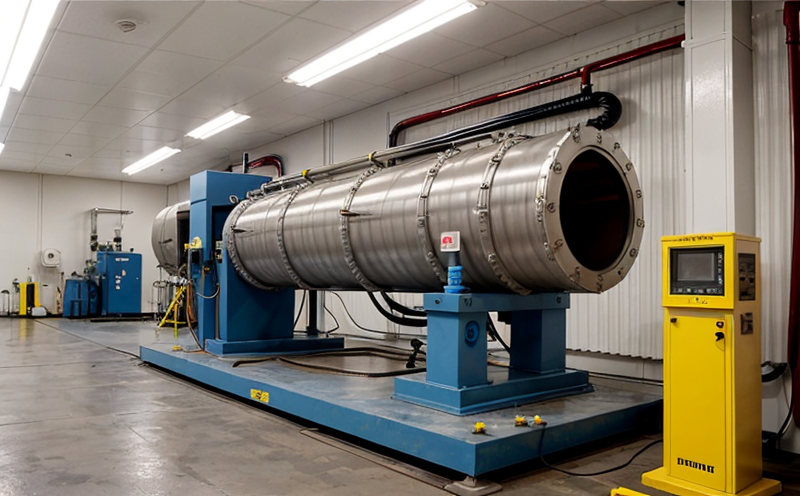ISO 18244 Metallographic Testing of Spent Nuclear Fuel
The ISO 18244 metallographic testing method is a critical process utilized in the nuclear fuel and isotope industry to assess the microstructure, composition, and integrity of spent nuclear fuel. This test is pivotal for ensuring compliance with international standards and for enhancing the reliability and safety of nuclear fuel cycles.
The testing procedure involves several key steps: sample preparation, etching, examination under a metallographic microscope, and interpretation of the results. The aim is to identify any defects or anomalies that could indicate potential issues in the fuel's performance during its operational life. This testing method is particularly important for spent nuclear fuel as it undergoes significant changes due to irradiation processes.
The ISO 18244 standard provides a detailed framework for conducting this test, ensuring consistency and accuracy across different laboratories worldwide. It specifies the use of specific etching solutions, magnification levels, and lighting conditions to ensure that the microstructure can be accurately observed and reported. This method is widely recognized in nuclear fuel research and development as well as in quality assurance programs.
The importance of this testing cannot be overstated, especially given the stringent requirements for safety and reliability in the nuclear industry. By adhering to ISO 18244 standards, laboratories ensure that their findings are credible and can be trusted by regulatory bodies and stakeholders alike. This process also aids in the optimization of fuel design and manufacturing processes, leading to more efficient and safer nuclear energy production.
In summary, ISO 18244 metallographic testing is a cornerstone of the nuclear fuel industry. It provides essential insights into the structural integrity and performance characteristics of spent nuclear fuel, thereby contributing significantly to the overall safety and efficiency of nuclear power generation processes.
Industry Applications
| Application Area | Description |
|---|---|
| Nuclear Research Laboratories | Conducting detailed assessments of fuel rod integrity and performance. |
| Nuclear Power Plants | Ensuring that spent nuclear fuel meets the required safety standards before disposal. |
| Regulatory Bodies | Verifying compliance with international standards for nuclear fuel quality. |
| R&D Facilities | Evaluating new fuel designs and materials for improved efficiency and safety. |
| Supplier Quality Assurance Programs | Ensuring the consistency and reliability of fuel products across different batches and suppliers. |
| Waste Management Companies | Determining the optimal conditions for safe storage and disposal of spent nuclear fuel. |
| Nuclear Medicine Facilities | Evaluating isotopes used in medical applications to ensure they meet stringent quality standards. |
Why Choose This Test
The ISO 18244 metallographic testing method is chosen for its precision and reliability. The process allows for a detailed examination of the microstructure of spent nuclear fuel, which is crucial for identifying potential flaws or defects that could compromise the safety and performance of the fuel. This level of scrutiny ensures that only high-quality materials are used in nuclear applications, thereby enhancing overall safety.
The method's adherence to international standards guarantees consistent results across different laboratories, making it easier for stakeholders to compare findings and make informed decisions. This uniformity is particularly important in a global industry where collaboration between countries and organizations is essential.
By using ISO 18244 metallographic testing, nuclear fuel manufacturers can optimize their production processes, leading to more efficient and safer products. The test also plays a vital role in the development of new fuel designs, enabling researchers to explore innovative materials and techniques that could improve fuel performance and longevity.
The reliability of this method is further enhanced by its robustness against variations in testing conditions. This ensures that results are accurate and repeatable, regardless of where or when the test is conducted. The use of advanced metallographic microscopes and etching solutions also contributes to the precision of the test, allowing for a thorough examination of even the smallest defects.
In conclusion, ISO 18244 metallographic testing is an indispensable tool in the nuclear fuel industry. Its precision, reliability, and adherence to international standards make it the preferred choice for ensuring the highest quality of spent nuclear fuel.
Environmental and Sustainability Contributions
The ISO 18244 metallographic testing method plays a crucial role in promoting environmental sustainability within the nuclear industry. By ensuring that spent nuclear fuel meets strict safety and performance standards, this test helps to minimize risks associated with radiation exposure and contamination. This, in turn, supports efforts to reduce the environmental impact of nuclear fuel cycles.
The use of advanced testing techniques allows for the identification of defects and anomalies in a non-destructive manner, ensuring that only high-quality materials are used in nuclear applications. This approach not only enhances safety but also reduces waste by eliminating substandard products from the supply chain.
In addition to improving product quality, ISO 18244 metallographic testing contributes to sustainable practices through its role in optimizing fuel design and manufacturing processes. By identifying areas for improvement, this test enables manufacturers to develop more efficient and durable fuels, reducing the need for frequent replacements and minimizing resource consumption.
The method also supports efforts to improve waste management by providing insights into optimal storage and disposal conditions for spent nuclear fuel. This knowledge helps to minimize environmental risks associated with improper handling and disposal practices.
In summary, ISO 18244 metallographic testing is a vital tool in promoting environmental sustainability within the nuclear industry. By ensuring high-quality materials are used and by optimizing production processes, this test supports efforts to reduce radiation exposure, minimize waste, and improve overall fuel performance.





